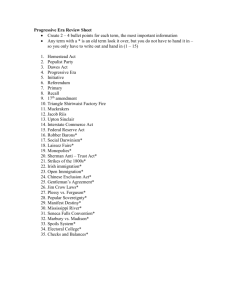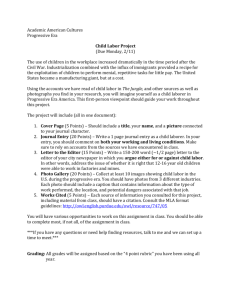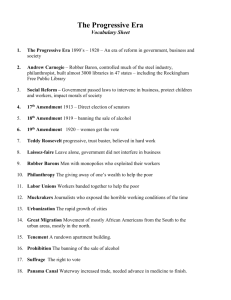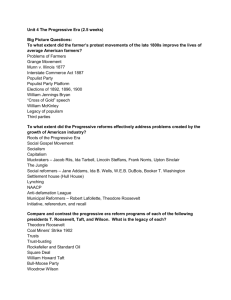Progressive Era
advertisement
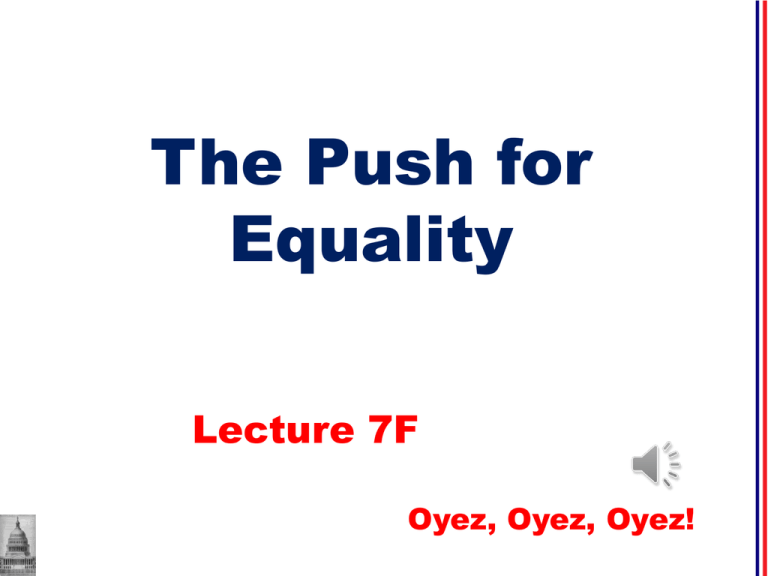
The Push for Equality Lecture 7F Oyez, Oyez, Oyez! Topics 1. What major events happened during the Progressive Era? 2. What role did the NAACP’s LDF play in litigating for equality? 3. What major events took place during the Civil Rights Movement? The Progressive Era Progressive Era 1890-1920. An effort to reform political, economic, and social affairs for many groups of people, particularly African Americans. • Aggravated by Plessy v. Ferguson The Progressive Era Plessy v. Ferguson (1896) Plessy was 7/8 Caucasian and 1/8 African American. He was picked to challenge a Louisiana law that required railroads to provide separate accommodations for blacks and whites. The Progressive Era Plessy v. Ferguson (1896) Court found that separate but equal accommodations did not violate the equal protection clause of the Fourteenth Amendment. • Created the separate-but-equal doctrine, which soon meant only separate and led to Jim Crow South with rigid social code The Progressive Era Plessy v. Ferguson (1896) Lone dissenter wrote: “The constitution is colorblind.” Supreme Court ruled against many of the protections that were created in the aftermath of the Civil War and Southern states readily followed along. The Progressive Era Founding of the National Association for the Advancement of Colored People (NAACP) In 1909, progressive reformers were concerned about outbreaks of violence. Oswald Garrison Villard called for a conference to discuss the problem. • Publisher of New York Evening Post • Grandson of William Lloyd Garrison • Group evolved into NAACP • Also included W.E.B. DuBois The Progressive Era Also, the Progressive Era brought a revitalization in women’s rights fight. • Susan B. Anthony led the National American Woman Suffrage Association • National Consumer’s League In a lawsuit about a limit to a woman’s workday, a NCL lawyer (and future Court justice) named Louis Brandeis urged members to put together materials for the trial. The Progressive Era Brandeis Brief Over 100 pages of legal arguments and more non-legal, sociological data to convince the Court. Court relied heavily on these data to document women’s unique status as mothers to justify their differential legal treatment. • Use of sociological data in a legal brief would become popular in many social justice movements. The Progressive Era Suffrage Movement The drive for voting rights for women that took place in the United States from 18901920. • Took on racist overtones in some places “the enfranchisement of women would ensure immediate and durable white supremacy,” according to some members of NAWSA. The Progressive Era Nineteenth Amendment Guaranteed women the right to vote. After passage, the unity of women’s groups largely disintegrated and would not emerge again until the 1960s. Litigating for Equality In 1930s, NAACP felt the time was right to challenge constitutionality of Plessy. Traditional legislative channels were unlikely to work, given blacks’ limited or nonexistent political power. So, federal courts were used with a long-range litigation strategy. Litigating for Equality Test Cases Part of NAACP litigation strategy. Use of strategic litigation to test the constitutionality of discriminatory policy and establish precedent. NAACP first challenged constitutionality of Jim Crow law schools because: • Something judges would relate to • Integration seen as less threatening to whites than grade school Litigating for Equality • Lloyd Gaines at University of Missouri Law School in 1936 NAACP Legal Defense Fund After Gaines, NAACP set up LDF to carefully craft cases based on education. Felt that Court would be amenable to NAACP’s broader goals if challenges first encompassed nonthreatening issues of educational opportunity. • First NAACP LDF head was Thurgood Marshall. Litigating for Equality • H.M. Sweatt at U. of Texas Law School • George McLaurin at U of OK Doctoral Program Supreme Court heard both cases together. Lots of amicus briefs submitted. Ruling: Court did not overturn Plessy, but did rule that both cases failed to live up to separate but equal doctrine. Litigating for Equality After these test cases, LDF felt time was right to launch a full-scale attack on separate but equal. • Decisions of Court had been favorable • Position of U.S. government • Population in general seemed more receptive Challenge came in form of Brown. Litigating for Equality Brown v. Board of Education (1954) Landmark Court decision holding that school segregation is inherently unconstitutional because it violates the Fourteenth Amendment’s guarantee of equal protection. • Most important civil rights case in the 20th century. Litigating for Equality Brown v. Board of Education (1954) Equal Protection Clause Section of the Fourteenth Amendment that guarantees that all citizens receive “equal protection under the law.” Litigating for Equality Brown v. Board of Education (1954) • Consisted of four cases • Argued by Thurgood Marshall and LDF lawyers • LDF proved intellectual, psychological, and financial damage of segregation • Lots of amicus briefs • Big backlash in the South • Implementation? Civil Rights Movement Brown v. Board of Education II (1955) One year after Brown, Court ruled that segregated schools systems must dismantle “with all deliberate speed.” • Court placed enforcement in hands of federal district judges because of immunity from politics • NAACP LDF continued to use courts to make sure Brown was implemented. Civil Rights Movement South entered into near conspiracy to avoid rulings and mandates • Faubus in Arkansas, for example Cooper v. Aaron (1958) “No state legislator or executive or judicial officer can war against the Constitution without violating his undertaking to support it.” • “Evasive schemes” were illegal Civil Rights Movement New Move for Rights • Rosa Parks • Martin Luther King, Jr. • Federal court ruled that segregated buses violated the equal protection clause. • SCLC • SNCC Civil Rights Movement King targeted massive nonviolent demonstrations in Birmingham, AL. • Triggered violent response from Birmingham police commissioner. • Shocked the nation • Events led to proposal of civil rights legislation Civil Rights Movement The Civil Rights Act of 1964 JFK requested a law banning discrimination in public accommodations. King seized on momentum and organized March on Washington for Jobs and Freedom in August of 1963. Bill was passed during LBJ’s administration. • Passage was not smooth. Civil Rights Movement The Civil Rights Act of 1964 Outlawed segregation in public facilities and racial discrimination in employment, education, and voting. Created the Equal Employment Opportunity Commission (EEOC). • Many challenged the constitutionality of the law, saying Congress did not have that type of power. Civil Rights Movement The Civil Rights Act of 1964 Heart of Atlanta Motel v. US (1964) Did Congress, in passing Title II of the Civil Rights Act of 1964 exceed its Commerce Clause powers by depriving motels, such as the Hear of Atlanta, of the right to choose their own customers? NO. Civil Rights Movement Legacy of C.R.A of 1964 in Education Even 10 years after Brown, in 1964, fewer than 1% of African American children in South attended integrated schools. Swann v. Charlotte-Mecklenburg S.D. (1971) All vestiges of de jure discrimination must be eliminated at once. Also, lower courts had authority to fashion a wide range of remedies (busing, racial quotas, etc.) Civil Rights Movement Legacy of C.R.A of 1964 in Education De Jure Racial segregation that is a direct result of law or official policy De Facto Racial discrimination that results from practice (like housing patterns or other social factors) rather than the law • Segregation in North? Civil Rights Movement Legacy of C.R.A of 1964 in Employment Title VII of the C.R.A. of 1964 prohibits employers from discrimination against employees for a variety of reasons (race, sex, age, national origin, pregnancy). Court ruled that an employer could be found liable for discrimination if the effects of employment practices exclude minorities from certain positions. Civil Rights Movement Voting Rights Act of 1965 Put in place federal authority to protect the right of African Americans to vote. • Eliminated literacy tests.
